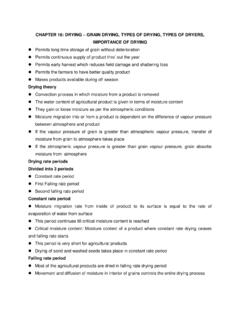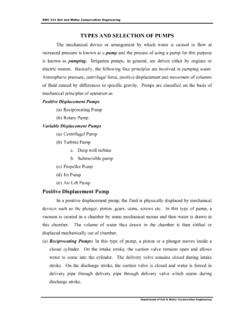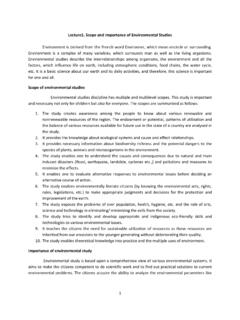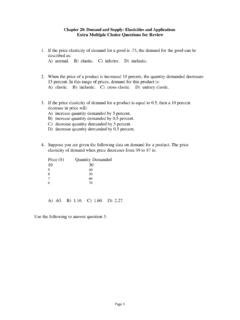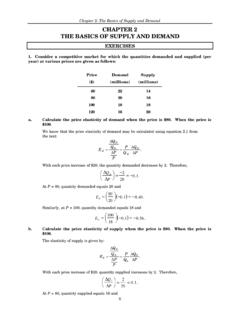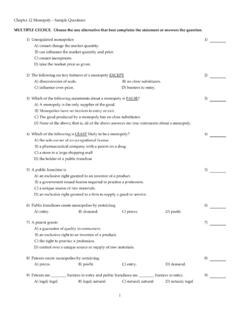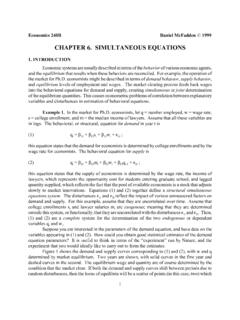Transcription of 06.Elasticity of demand – price, income and cross ...
1 Percentage Change in Quantity Demanded Ep = Percentage Change in Price or in symbolic terms, Q x 100 Q Q Q Q P Q P Ep = = = x = x P x 100 P Q P P Q P P 2 /10 x100 20
2 Ep = = = - 4 -5 /100 x 100 -5 of demand price, income and cross elasticities estimation point and arc elasticity - Giffen Good normal and inferior goods substitutes and complementary goods elasticity OF demand elasticity of demand refers to the sensitiveness or responsiveness of demand to changes in price. Price elasticity of demand is usually referred to as elasticity of demand . Also, there are income elasticity of demand and cross elasticity of demand .
3 I) Price elasticity of demand It is the ratio of proportionate change in quantity demanded of a commodity to a given proportionate change in its price. Price elasticity of demand (EP) is, thus, given by: Where, Q = quantity demanded of a commodity; P= Price. Let us suppose that a consumer demands 10 oranges when its unit price is Re. 1. If its price falls to 95 paise, he demands 12 oranges. Now, the price elasticity of demand can be estimated as follows: As the price falls by 5 per cent, the quantity demanded raises by 20 per cent.
4 Now, the coefficient of elasticity of demand is minus 4. Thus, it could be concluded that there is a four per cent increase in the quantity demanded of orange due to one per cent decrease in its price. a) Types of elasticity of demand : Price elasticity of demand is classified under the following five sub heads: P0 Ep = Price Price Ep = 0 P0 P1 0 Q0 Q1 Quantity Demanded (c) Relatively Elastic Ep > 1 Price Price P0 P1 0 Q0 Q1 Quantity Demanded (d) Relatively Inelastic 0 < Ep < 1 Price P0 P1 0 Q0 Q1 Quantity Demanded (e) Unitary Elastic Ep=1 Q0 Q1 Q0 Quantity Demanded Quantity Demanded Fig.
5 (a) Perfectly Elastic Fig. (b) Perfectly Inelastic P0 P1 1. Perfectly elastic demand : It refers to the situation where the slightest rise in price causes the quantity demanded of a commodity to fall to zero and at the present level of price people demand infinitely large quantity of the commodity. The coefficient of elasticity of demand is infinite. 2. Perfectly inelastic demand : It refers to the situation where even substantial changes in price do not make any change in the quantity demanded, , for any change in the price, the demand remains constant.
6 The coefficient of elasticity of demand is zero. 3. Relatively elastic demand : Here, a small proportionate change in the price of a commodity results in a larger proportionate change in its quantity demanded. The coefficient of elasticity of demand is greater than unity. 4. Relatively Inelastic demand : A larger proportionate change in the price of a commodity results in a smaller proportionate change in its quantity demanded. The coefficient of elasticity of demand is greater than zero, but less than unity.
7 5. Unitary elastic demand : It refers to a situation where a given proportionate change in price is accompanied by an equally proportionate change in the quantity demanded. In other words, a given proportionate fall in the price is followed by an equally proportionate increase in demand and vice versa. The co efficient of elasticity of demand is unity. b) Factors Influencing the elasticity of demand : The elastic or inelastic nature of the demand for a commodity is determined by the following factors.
8 1) Degree of necessity: Other things being equal, the demand for necessities is inelastic or less elastic than that for comforts and luxuries. The reason is simple. The necessities must be bought whatever be the price because no one can live without them. The demand for a necessity without a substitute is less elastic than the demand for a necessity with a substitute. For example, the demand for salt is less elastic than that for paddy. 2) Proportion of consumer s income spent on the commodity: The demand for a commodity on which the consumer spends only a small proportion of his income is less elastic.
9 For instance, even if the price of salt or match-box rises by 100 per cent, the demand for them may not decline substantially. 3) Existence of substitutes: The demand for a commodity is more elastic, if it has a number of good substitutes. A small rise in the price of such a commodity will induce the consumers to go for its substitutes, assuming that their prices do not rise. 4) Several uses of the commodity: The demand for a commodity is said to be more elastic, if it can be put to a variety of uses.
10 A fall in the price of electricity will result in the substantial increase in its demand . 5) Time: The elasticity of demand varies with the length of time. In general, demand is more elastic for longer period of time. For instance, if the price of kerosene rises, it may be difficult to substitute it with cooking gas within a very short time. But if sufficient time is given, people will make adjustments and use firewood or cooking gas instead of kerosene. c) Measurement of elasticity of demand : Price elasticity of demand can be measured by three methods.


